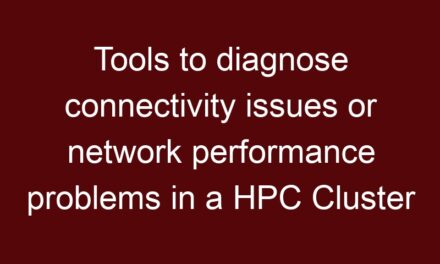Optimizing InfiniBand network performance involves tuning various parameters and settings to ensure efficient communication, low latency, and high throughput. Here are some key parameters and settings that can be tuned to optimize InfiniBand network performance:
- MTU (Maximum Transmission Unit):
Increasing the MTU can improve efficiency by reducing the overhead associated with smaller packet sizes. However, ensure that all devices in the network support the selected MTU size. - VLs (Virtual Lanes):
Configure Virtual Lanes with appropriate priorities based on application requirements. Assign higher priorities to latency-sensitive traffic and lower priorities to bulk data transfers. - QoS (Quality of Service):
Utilize QoS mechanisms to allocate bandwidth and prioritize traffic based on application needs. This prevents resource contention and ensures that critical traffic gets the required resources. - Buffer Sizes:
Adjust the size of receive and send buffers in InfiniBand adapters and switches to match the characteristics of your applications. Larger buffers can help handle bursts of traffic more efficiently. - Partitioning:
Utilize partitioning to isolate different workloads or applications in separate logical segments. This prevents interference and optimizes resource allocation for each partition. - Path Selection Policies:
Configure path selection policies to optimize routes based on application communication patterns. Policies can prioritize shorter paths or paths with lower latency. - Subnet Manager (SM) Configuration:
Fine-tune SM settings, including timeouts and retries, to optimize fabric discovery and error handling. - Adaptive Routing:
Enable adaptive routing to dynamically adjust routing paths based on network conditions, which can improve fault tolerance and load balancing. - Congestion Management:
Configure congestion management mechanisms to detect and manage congestion. This helps prevent performance degradation during high traffic loads. - Link Layer Flow Control:
Enable link layer flow control to manage data flow between devices and prevent data loss due to buffer overflows. - RDMA (Remote Direct Memory Access) Configuration:
Optimize RDMA settings, such as RDMA read and write permissions, to maximize data transfer efficiency. - HCA Driver and Firmware Updates:
Keep Host Channel Adapter (HCA) drivers and firmware up-to-date to benefit from performance improvements and bug fixes. - Topology Optimization:
Design the physical topology to minimize cabling complexity and ensure efficient connections between devices. - Security Settings:
Configure security settings appropriately to prevent unauthorized access and ensure data integrity. - Monitoring and Diagnostics:
Utilize monitoring tools to regularly assess network performance and identify potential issues. Diagnose and address performance bottlenecks promptly. - System-Level Optimization:
Consider system-level factors like CPU affinity, memory usage, and process/thread distribution to optimize the overall performance of applications using the InfiniBand network.
It’s important to note that the optimal settings may vary based on the specific workload, application requirements, and the InfiniBand hardware and software being used. Thorough testing and monitoring are essential when tuning these parameters to achieve the best performance for your particular environment.





